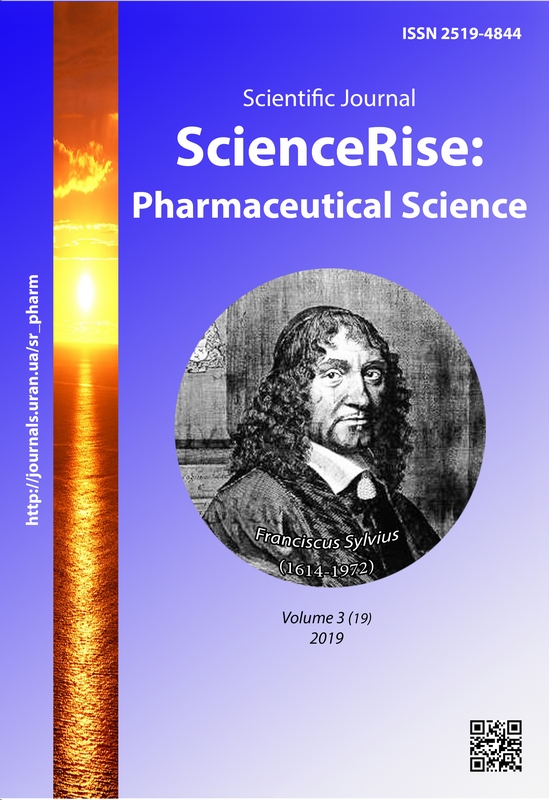Investigations with the aim of obtaining a mass for pressing medicated chewing gums "Lysodent C"
DOI:
https://doi.org/10.15587/2519-4852.2019.172272Keywords:
medicated chewing gums, granulate of lysozyme hydrochloride, mass for pressing, physicochemical and pharmacotechnological studiesAbstract
The design of high quality compressed medicated chewing gum "Lysodent C" with lysozyme hydrochloride and ascorbic acid as active pharmaceutical ingredients and the composition Health in Gum® PWD-01 as a chewable gum base involves obtaining a homogeneous mass for pressing. In order to prevent the segregation of the mass for pressing due to its polydispersity, it was necessary to carry out a preliminary granulation of the substance of lysozyme hydrochloride, which is characterized by fine dispersion, hygroscopicity and insufficient pharmacotechnological properties for direct compression method.
Aim of the work – to carry out physicochemical and pharmacotechnological studies in order to obtain a homogeneous mass for pressing medicated chewing gums "Lysodent C".
Materials and methods. The objects of study are granulate of lysozyme hydrochloride (Bouwhuis Enthoven, the Netherlands) with an intensive sweetener sucralose (Solo Sucralose-Non Micronised NF, VB Medicare PVT. LTD., India) and a flavoring agent (Nat Apple Flavor Wonf, Kerry Inc., Malaysia), and also a mass for pressing, obtained by mixing the granulate, the composition Health in Gum® PWD-01 (Cafosa, Spain) and ascorbic acid (Foodchem, China). As a granulating liquid ethanol 96 % was used. During the experiment, physicochemical (moisture absorption capacity), pharmacotechnological (optical microscopy, flowability, bulk density and tapped density, determination of particle size by analytical sieving) and statistical studies in accordance with the requirements of SPhU 2.0 were used.
Results. Crystallographic analysis revealed similarity in size and shape of the obtained lysozyme hydrochloride granulates with the granules of Health in Gum® PWD-01, which was also confirmed by the study of the fractional composition – particles with a size of 1.0 > n ≥ 0.7 are their main fraction. In addition, the conversion of lysozyme hydrochloride powder to granules improved its pharmacotechnological characteristics. However, granulate, like the pure substance of lysozyme hydrochloride, is hygroscopic, which requires, respectively, a decrease in its moisture absorption capacity. Crystallographic analysis of the mixture obtained by mixing the granulate and Health in Gum® PWD-01 with premixing of ascorbic acid, established its dispersion homogeneity, and the study of its technological characteristics – good flowability, which will ensure high-quality compressed gums. The moisture absorption capacity of the formed mass for pressing did not decrease, but on the contrary increased, due to the presence in the mixture of such hygroscopic components as lysozyme hydrochloride and chewing gum base.
Conclusions. It was established that the use of pre-granulation of lysozyme hydrochloride led to the homogeneity of the resulting mass for pressing. However, the hygroscopicity of the mixture requires the introduction of moisture-absorbing agents in its composition or compliance with 40 % of the relative humidity of the environment during the preparation of the drug
References
- Aslani, A., Rostami, F. (2015). Medicated chewing gum, a novel drug delivery system. Journal of Research in Medical Sciences, 20 (4), 403–411. Available at: https://www.ncbi.nlm.nih.gov/pmc/articles/PMC4468459/
- Khairnar, D. A., Darekar, A. B., Saudagar, R. B. (2016). Medicated Chewing Gum is an Excellent Drug Delivery System for Self Medication. Asian Journal of Pharmaceutical Research, 6 (1), 24–30. doi: http://doi.org/10.5958/2231-5713.2016.00004.0
- Belmar, J., Ribé, M. (2013). Eye on Excipients. As appeared in Tablets & Capsules. Available at: http://www.healthingum.com/pdf/Eye%20on%20excipients.pdf
- Cafosa. Gum based for every chewing gum you may have in mind. Available at: http://www.cafosa.com
- Maslii, Y. S., Ruban, O. A., Kovalevska, І. V. (2019). The choice of intense sweetener in the composition of medicated chewing gum under development. Farmatsevtychnyi Zhurnal, 5-6, 70–79. doi: http://doi.org/10.32352/0367-3057.5-6.18.05
- Chuieshov, V. I., Hladukh, Ye. V., Saiko, I. V. et. al. (2012). Tekhnolohiia likiv promyslovoho vyrobnytstva. Part 1. Kharkiv: NFaU: Oryhinal, 694.
- Razdel 2.4.1. Fiziko-khimicheskie svoistva. Razdel 2.4.2. Tekhnologicheskie svoistva. Available at: http://ztl.nuph.edu.ua/html/medication/chapter14_04.html
- Maslii, Y. S., Ruban, A. A., Olkhovska, A. B. (2017). Marketing analysis of therapeutic chewing gum assortment on the modern pharmaceutical market. Zbirnyk naukovykh prats NMAPO imeni P. L. Shupyka, 27, 286–298. Available at: http://dspace.nuph.edu.ua/bitstream/123456789/14089/3/286.pdf
- Koval, V. M., Denys, A. I., Hroshovyi, T. A., Vronska, L. V. (2018). Medicated chewing gums: prescription, technology and analysis. Pharmaceutical Review, 1, 152–160. doi: http://doi.org/10.11603/2312-0967.2018.1.8700
- Shahid, M. S., Niranjan, B. M. (2014). Medicated chewing gum – an overview. International Journal of Research in Pharmaceutical and Nano Sciences, 3 (4), 277–289. Available at: http://www.ijrpns.com/article/MEDICATED%20CHEWING_GUM%20%E2%80%93%20AN%20OVERVIEW.pdf
- Derzhavna Farmakopeia Ukrainy. Vol. 1 (2015). Kharkiv: Derzhavne pidpryiemstvo «Ukrainskyi naukovyi farmakopeinyi tsentr yakosti likarskykh zasobiv», 1128.
- Meeus, L. (2011). Direct compression versus granulation. Pharmaceutical Technology Europe, 23, 21–22. Available at: http://www.pharmtech.com/direct-compression-versus-granulation
- Slipchenko, H. D. (2012). Complex estimation ground up raw material scutellaria baicalensis. Farmatsevtychnyi zhurnal, 5, 58–62. Available at: http://nbuv.gov.ua/UJRN/pharmazh_2012_5_12
Downloads
Published
How to Cite
Issue
Section
License
Copyright (c) 2019 Yuliia Maslii, Olena Ruban, Tetiana Kolisnyk

This work is licensed under a Creative Commons Attribution 4.0 International License.
Our journal abides by the Creative Commons CC BY copyright rights and permissions for open access journals.








